I’m sharing a Fabulous Three-Course Welsh Menu today, using Welsh produce, from Llyn Peninsula crab, and Welsh Ale to Welsh Cheese, Chicken and Vegetables.
*Ad – Sponsored Commissioned Post*
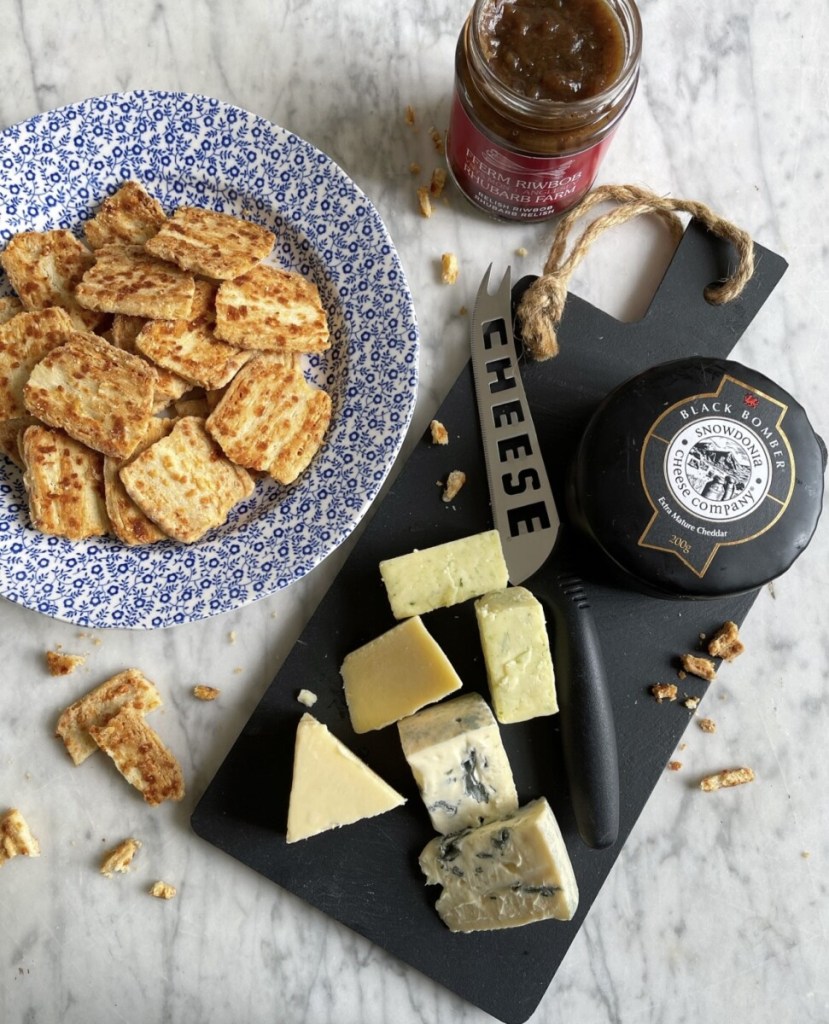
A Celebration of Welsh Produce

I’m sharing a Fabulous Three-Course Welsh Menu today, using Welsh produce, from Llyn Peninsula crab, and Welsh Ale to Welsh Cheese, Chicken and Vegetables.
The menu is as follows: Crab Welsh Rarebit, Welsh Chicken in a Mead & Honey Sauce with Leeks and A Welsh Cheese Platter with Welsh Cheeseboard Crackers.
All of these recipes are shared at the end of this post, and use local Welsh produce to highlight what a cornucopia of amazing food and drink we have in Wales.

I try to cook seasonally and shop locally, and when you have some of the world’s best meat, poultry, vegetables and seafood on your doorstep, it makes sense to utilise it, whilst supporting your local community and the people who grow and produce it all.
Living at the neck of the stunning Llyn Peninsular, as well as vegetables, cheese, sea salt, butter, Welsh mountain lamb and Welsh beef, I have access to the most amazing seafood too, of which our favourites are the Menai oysters and mussels in nearby Anglesey.
Wales, as a whole, and especially where I live in North Wales, is a veritable cornucopia of food and drink, which can be enjoyed in Wales, as well as outside Wales too, of course.

The first course is a rather sumptuous Crab Welsh Rarebit. Made with fresh Llyn Peninsula crab, Welsh cheese and local Welsh Ale, it is so easy to make, and highlights some of Wales’s best ingredients and produce.
Use 1 slice of sourdough or good thick, sliced bread per person for a main meal or substantial snack, or half a slicer per person for an elegant starter dish.
Serve with salad leaves, watercress or mustard & cress, and a glass of Welsh ale for the win!
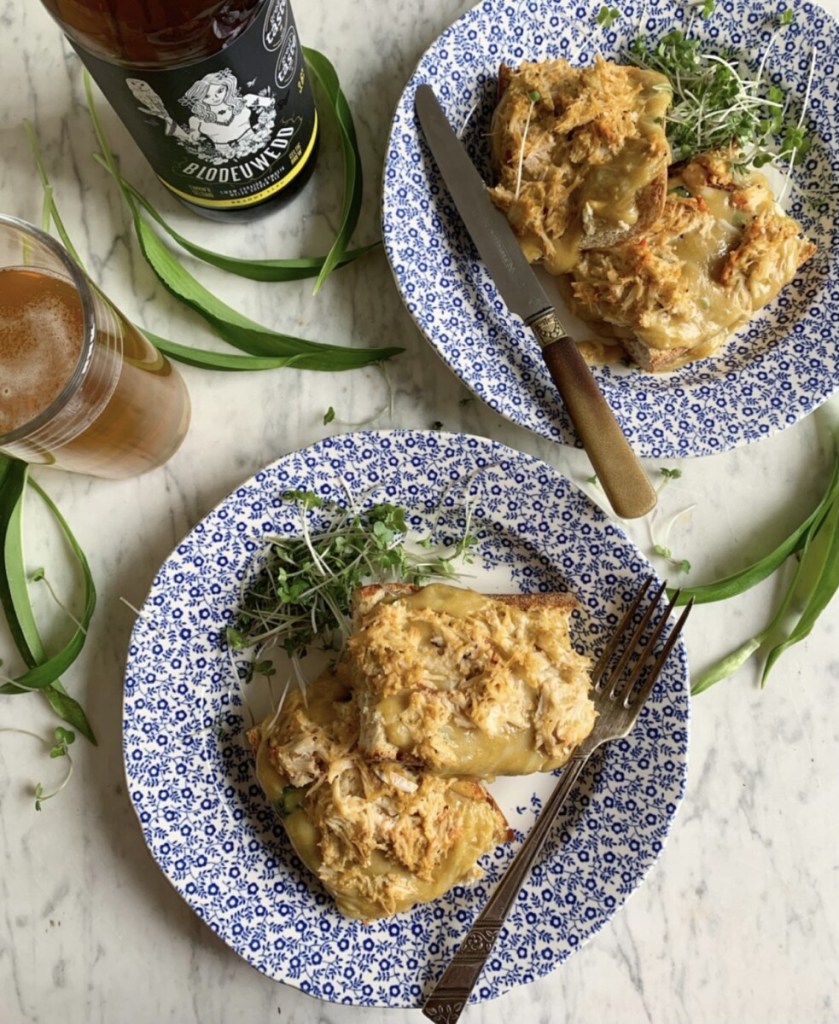
Next up is a delicious recipe for Welsh Chicken in a Mead & Honey Sauce with Leeks. Served with Pembrokeshire baby (or new) potatoes, and has an option to add baked dumplings for the winter months.
The Welsh mead and honey adds a wonderful sweetness, which marries so well with the salty bacon, and enhances the sweetness of the leeks and succulent chicken.
There are numerous traditional Welsh recipes that use leeks, such as Cawl (Wales’s national dish), Glamorgan Sausages (Selsig Morgannwg) and Leek Pudding.
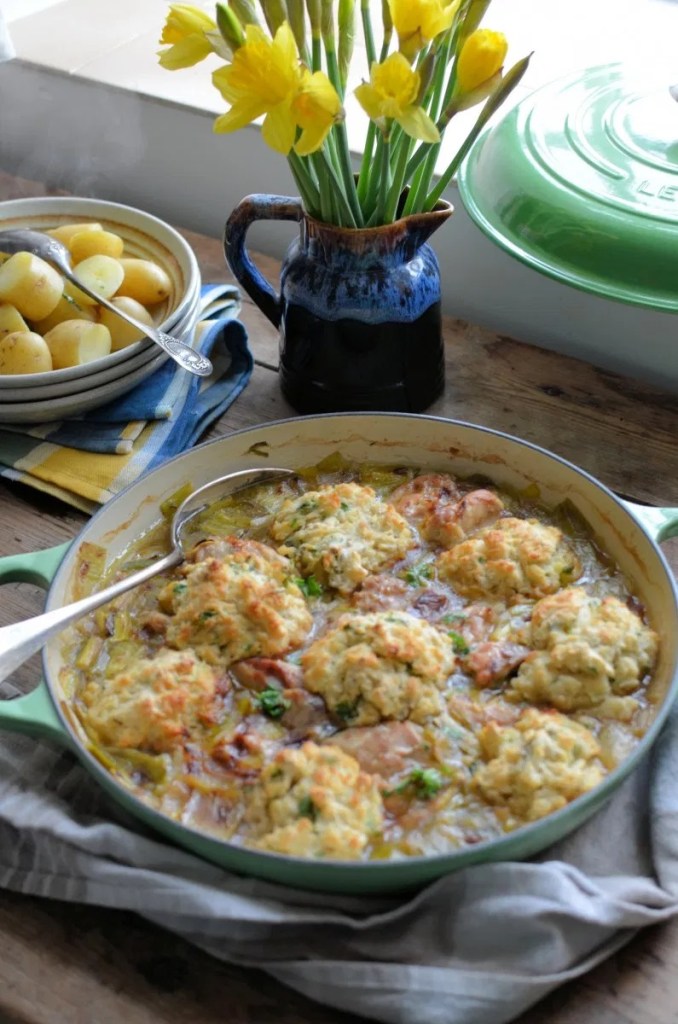
Finally, why not indulge in a Welsh Cheeseboard, with some homemade Welsh Cheeseboard Crackers. These are made with ready-made puff pastry and Welsh Cheddar cheese.
I used Snowdonia Black Bomber Extra Mature Cheddar cheese last time I baked these. However, any mature or vintage Cheddar (or hard cheese) will work.
These Welsh Cheeseboard Crackers are fabulous with all sorts of cheese, but especially a selection of Welsh cheeses, such as Perl Las (a blue cheese), Y Fenni (a beer and wholegrain mustard cheese), Gorwydd Caerphilly (a farmhouse style Caerphilly chese), Drewi Sant (a mead washed cheese) and Black Bomber of course.
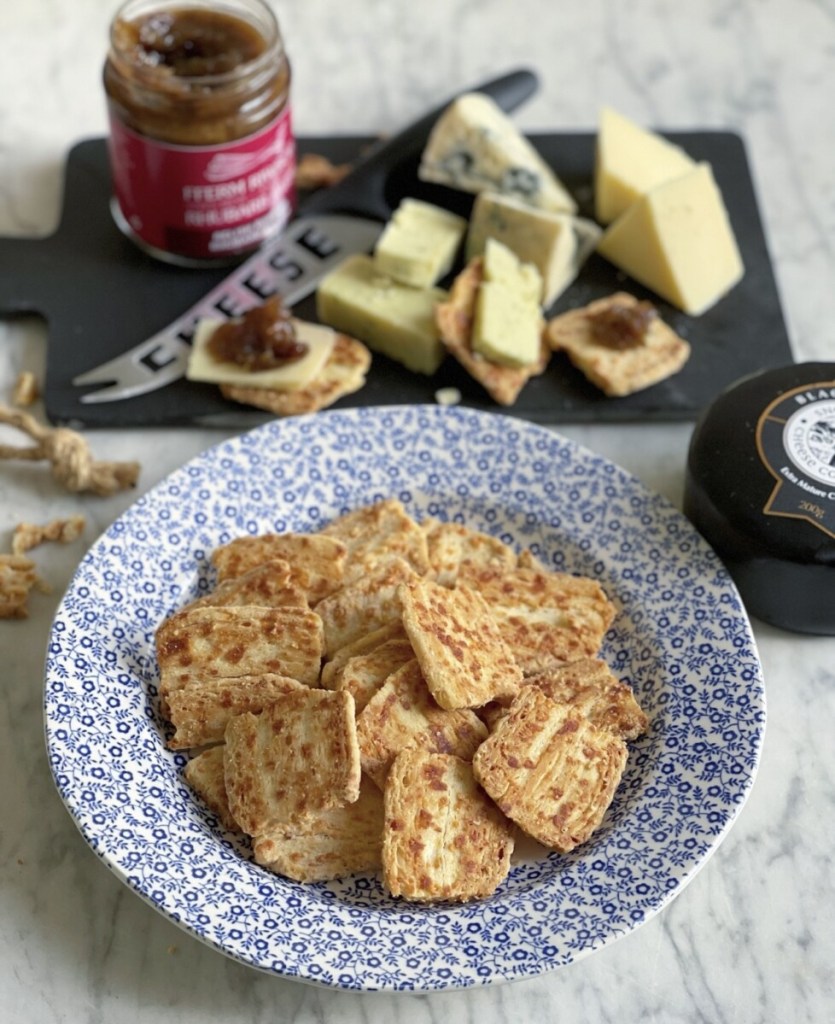
More Welsh Recipes on Lavender & Lovage
These Crempogau, or more correctly Crempog Furum, are based on an old recipe from the 1800’s and one that uses yeast.
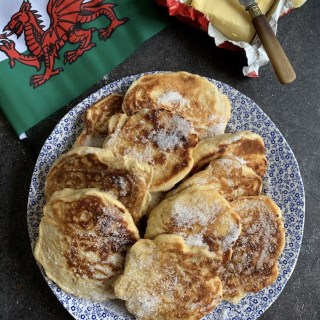
oday’s recipe for Welsh Onion Cake is a traditional Welsh recipe, where the humble potato takes centre stage along with onions and butter.
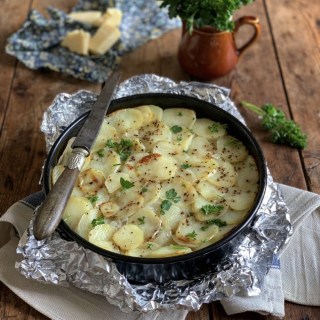
A wonderful recipe for a Welsh farmhouse classic, TEISEN LAP, also known as “wet cake” or “moist cake”.
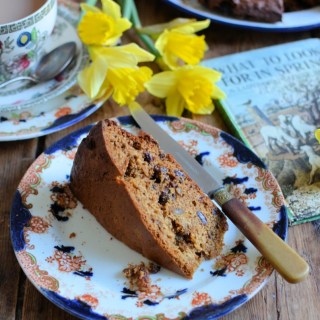
Griddles, Girdles and Hot Cakes: Traditional Welsh Cakes
Traditional Welsh Cakes: The recipe I am sharing today comes from one of my old Be-Ro cookbooks and is the ONLY recipe I use when I make a batch of Welsh Cakes; it’s the very same recipe that my grandmother used, as well as my mum, and the recipe never fails.
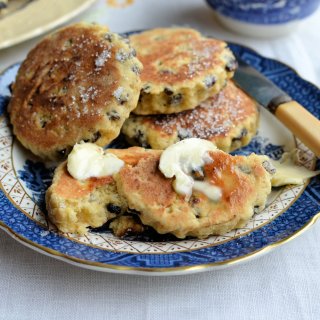
Welsh Cawl (Lamb & Vegetable Stew)
Welsh Cawl (Lamb & Vegetable Stew) – Cawl is often seen as being the national dish of Wales, my recipe is based on a traditional Welsh recipe for Cawl, but uses lamb steaks in place of a lamb joint, as was commonly used in times gone by. A bowl of cawl is usually accompanied by crusty bread and Caerphilly cheese, and makes a wonderfully comforting family supper dish.
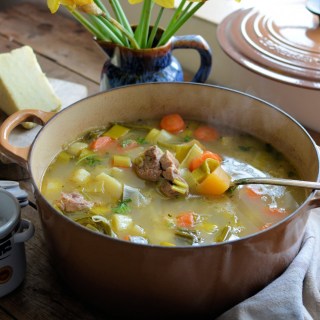
Glamorgan Sausages (Selsig Morgannwg)
These veggie bangers have some history behind them it appears; they were traditionally made and served for breakfast, and George Borrow, a fascinating character, is known to have mentioned them in his book called Wild Wales based on his travels in Wales during the 1850’s.
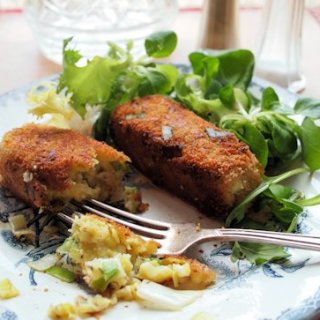
The Recipes

Crab Welsh Rarebit
This recipe for Crab Welsh Rarebit makes a wonderful snack, or starter. Made with fresh Llyn Peninsula crab, Welsh cheese and Ale, it is so easy to make, and highlights some of Wales's best ingredients and produce.
Use 1 slice of sourdough or good thick, sliced bread per person for a main meal or substantial snack, or half a slicer per person for an elegant starter dish.
Serve with salad leaves, watercress or mustard & cress, and a glass of Welsh ale for the win!
When wild garlic is in season, add chopped wild garlic to the rarebit mixture in place of parsley. Chopped chives also works well in this recipe.
Once the rarebit mixture has been made, you can store it in the fridge for 2 to 3 days, once it is cool. If you are preparing the crabmeat yourself, the extracted crabmeat can also be store in the fridge for 1 to 2 days too, making it a fabulous recipe to pre-prepare.
Ingredients
- 300g cooked white crabmeat
- Juice from 1 lemon
- 2 tablespoons mayonnaise
- 1 tablespoon chopped fresh parsley
- Salt and pepper, to taste
- 4 slices sourdough or crusty sliced bread
- Rarebit Mixture:
- 350g Welsh Cheddar cheese, grated (I used Snowdonia Black Bomber)
- 50ml Welsh beer
- 2 tablespoons plain flour
- 1 tablespoon Worcester sauce
- 1 teaspoon English mustard
- 2 to 3 drops of Tabasco
- 2 egg yolks
Instructions
- Mix the crabmeat with the lemon juice, mayonnaise, parsley and season to taste with salt and pepper.
- Melt the cheese in a pan over a gentle heat, before adding the rest of the rarebit ingredients.
- Cook together over a gentle heat for 2 to 3 minutes, stirring all the time until you have a smooth mixture.
- Toast the bread on both sides and turn on the grill. Sit the toast on a lined grill pan or oven tray.
- Spoon the rarebit mixture over the toast, then divide the crab mixture on top of the cheese rarebit mixture.
- Grill until it is all bubbling and the rarebit is golden brown.
- Remove and serve immediately with salad, cress and chutney.
Notes
When wild garlic is in season, add chopped wild garlic to the rarebit mixture in place of parsley. Chopped chives also works well in this recipe.
Once the rarebit mixture has been made, you can store it in the fridge for 2 to 3 days, once it is cool. If you are preparing the crabmeat yourself, the extracted crabmeat can also be store in the fridge for 1 to 2 days too, making it a fabulous recipe to pre-prepare.
You can also mix the cooked crab mixture with the rarebit mixture for a smoother texture.
Use light ale for the best results, such as an IPA.
Any mature or vintage hard cheese works well in this recipe.
Nutrition Information
Yield 4 Serving Size 1Amount Per Serving Calories 749Total Fat 39gSaturated Fat 19gTrans Fat 1gUnsaturated Fat 16gCholesterol 255mgSodium 1571mgCarbohydrates 54gFiber 3gSugar 12gProtein 43g
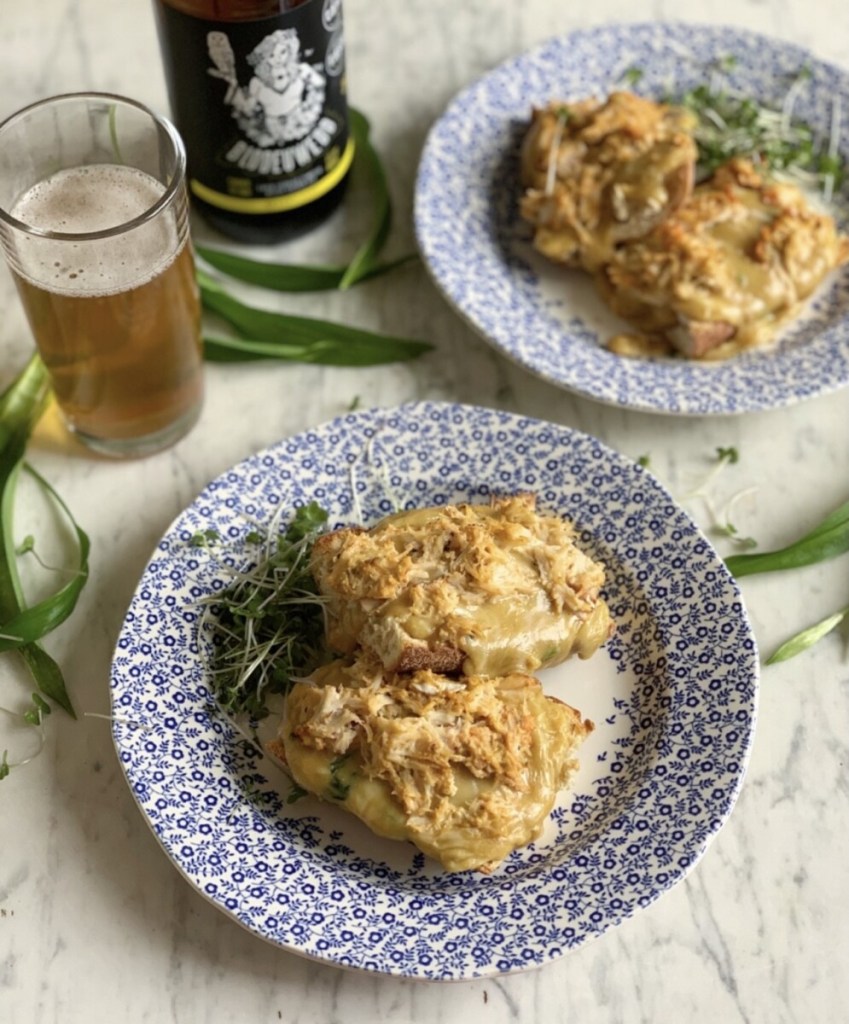

Welsh Chicken in a Mead & Honey Sauce with Leeks
This recipe for Welsh Chicken in a Mead & Honey Sauce with Leeks is served with Pembrokeshire baby potatoes, and has an option to add baked dumplings for the winter months.
The mead and honey adds a wonderful sweetness, which marries so well with the salty bacon, and enhances the sweetness of the leeks and succulent chicken.
Using locally sourced Welsh ingredients with provenance, this recipe is a real winner, and would be perfect for any family supper to celebrate St David's Day. It would also make a fabulous Sunday lunch dish, as well as a hearty mid-week family supper dish.
Organic Welsh chicken is paired with locally grown Welsh leeks and shallots, which are cooked in a rich mead and honey sauce, before being served with baby or new potatoes.
I try to cook seasonally and shop locally, and when you have some of the world’s best meat, poultry, vegetables and seafood on your doorstep, it makes sense to utilise it, whilst supporting your local community and the people who grow and produce it all.
Living at the neck of the stunning Lleyn Peninsular, as well as vegetables, cheese, sea salt, butter, Welsh mountain lamb and Welsh beef, I have access to the most amazing seafood too, of which our favourites are the Menai oysters and mussels in nearby Anglesey.
Wales, as a whole, and especially where I live in North Wales, is a veritable cornucopia of food and drink, which can be enjoyed in Wales, as well as outside Wales too, of course.
This recipe uses one of Wales’s most popular vegetables, as well as being one of the national emblems of Wales, the leek. Having lived with my maternal grandparents in Northumberland in England when I was little, I know and understand the importance of this humble vegetable, as it is an important symbol of growing and providing food for your family there, as it is in Wales.
There are numerous traditional Welsh recipes that use leeks, such as Cawl (Wales’s national dish), Glamorgan Sausages (Selsig Morgannwg) and Leek Pudding.
The optional baked dumplings are very reminiscent of Welsh oatmeal dumplings, and have herbs added for extra colour and flavour.
And, you don’t have to be in Wales or Welsh to enjoy my recipe! You can use chicken breasts in place of chicken thighs, but I prefer chicken thighs for texture and flavour, and they hold up better in a casserole and don’t dry out.
Ingredients
- Welsh Chicken in a Mead & Honey Sauce with Leeks:
- 1 tablespoon rapeseed oil
- 125g smoked lardons (or smoked streaky bacon cut into small pieces)
- 4 shallots, peeled and diced
- 8 skinless, boneless chicken thighs
- 3 leeks, trimmed, washed and sliced (use the white and the green)
- 400ml chicken stock
- 50ml Welsh mead
- 1 tablespoon Welsh honey
- Sea salt and pepper to taste (I used Halen Môn Anglesey Sea Salt)
- Chopped fresh parsley
- Dumplings (Optional):
- 225g self raising flour
- 1 teaspoon dried herbs (such as parsley, sage, thyme, majoram and rosemary) (or 1 tablespoon of fresh herbs)
- sea salt and pepper to taste (I used Halen Môn Anglesey Sea Salt)
- 110g shredded vegetable or beef suet, water, to mix
- To serve:
- New or baby potatoes
Instructions
1. In a large oven-proof shallow sauté pan that has a lid, heat the oil and then add the lardons and shallots; fry over a gentle heat until the bacon fat is crisp and the shallots are soft. Push the bacon and shallots to one side, or remove, and add the chicken thighs, increase the heat and cook the chicken until it is a pale golden brown. Add the bacon and shallots back into the pan if removed, before adding the chopped leeks.
2. Sauté the leeks for 2 to 3 minutes and the add the chicken stock, mead, honey and season to taste with salt and pepper, cover with a lid and simmer over a low heat for 25 to 30 minutes, or until the chicken and leeks are cooked.
3. Remove from the oven, scatter the fresh parsley over the casserole and serve straight away with steamed baby potatoes.
4. OPTIONAL BAKED DUMPLINGS: Whilst the chicken casserole is simmering, pre-heat the oven to 200C/400F/Gas mark 6 and make the dumplings; Mix the flour with the salt, pepper and herbs in a mixing bowl. Stir in the suet and then add water VERY carefully and slowly - mixing in between, until the dumpling dough is soft, but not sticky. Shape the dough into 8 round dumplings.
5. Take the casserole off the hob, take the lid off, and drop the dumplings on top of the chicken and leeks, place the casserole dish in the pre-heated oven and bake for 20 minutes until the dumplings are well-risen , crusty and golden brown.
6. Serve as before in step 3.
Notes
Omit the bacon of you want.
Mushrooms can be added if you wish.
For a creamy sauce, add a tablespoon or 2 of crème fraiche with the stock, mead and honey.
If you can't get hold of mead, use cider or perry instead.
Nutrition Information
Yield 6 Serving Size 1Amount Per Serving Calories 620Total Fat 25gSaturated Fat 8gTrans Fat 0gUnsaturated Fat 15gCholesterol 214mgSodium 1041mgCarbohydrates 50gFiber 4gSugar 12gProtein 51g
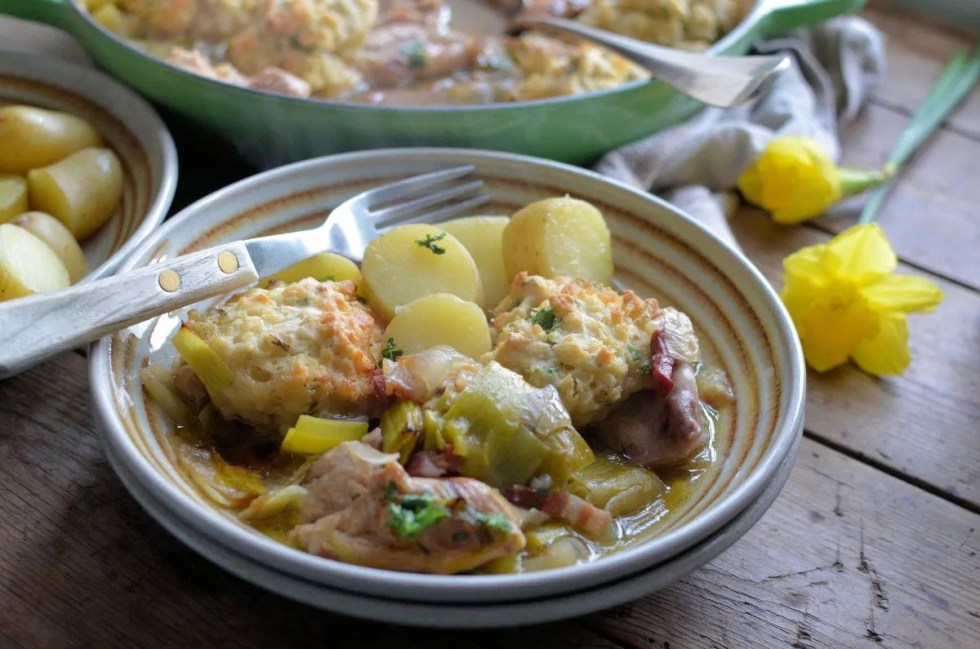
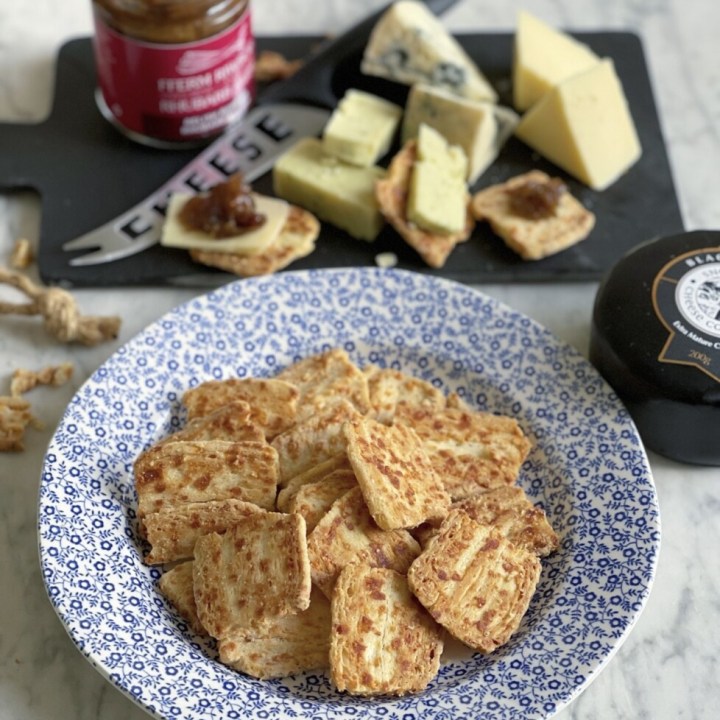
Welsh Cheeseboard Crackers
These delectable and very moreish Welsh Cheeseboard Crackers are made with ready-made puff pastry and Welsh Cheddar cheese.
To get the flat and very crisp finish and texture, you simply bake them in a very "cheffy" way, by placing a baking tray on top of them whilst they cook.
This ensures they don't puff up too much, but, you can cook them without the baking tray if you want a puffy finish.
I used Snowdonia Black Bomber Extra Mature Cheddar cheese last time I baked these. However, any mature or vintage Cheddar (or hard cheese) will work.
These Welsh Cheeseboard Crackers are fabulous with all sorts of cheese, but especially a selection of Welsh cheeses, such as Perl Las (a blue cheese), Y Fenni (a beer and wholegrain mustard cheese), Gorwydd Caerphilly (a farmhouse style Caerphilly chese), Drewi Sant (a mead washed cheese) and Black Bomber of course.
For more Welsh cheeses, that you can buy online, visit The Welsh Cheese Company, who stock over 60 Welsh cheeses, as well as a selection of chutneys etc.
I also served these Welsh Cheeseboard Crackers with some Welsh rhubarb chutney, although I have lots of fabulous homemade chutney recipes on Lavender & Lovage here: Chutney and Pickles.
These crackers stay crisp and fresh in an airtight tin for 2 to 3 days, but as they are so easy to make, I think they are best served on the day of baking, as they do lose some of their crispness after a couple of days.
You have to use the block puff pastry to get the best results, as you can slice off what you need before adding the cheese, rolling and then baking, which keeps the lamination more intact.
Ingredients
- 500g block of puff pastry, defrosted if frozen
- 250g extra mature or vintage Cheddar cheese, grated
- Flour, for dusting
Instructions
- Pre-heat oven to 200C/180C Fan/400F/Gas mark 5. Line two large baking trays with greaseproof paper or baking parchment. Cut two pieces of extra greaseproof paper or baking parchment that is the exact size of the trays - these are to sit on top of the crackers whilst baking.
- Divide the pastry by cutting it into 6 strips. On a floured board, take one strip and roll it out, then scatter some of the cheese over it, fold the pastry over from both sides, to cover the cheese, and roll out again. Do this one more time, then cut the pastry into 10 square crackers. (Or stamp out rounds if you prefer)
- Continue to do this for all the strips of pastry, placing them on the lined baking trays. You will probably need to bake the crackers in two lots.
- Place the extra sheet of baking paper over the crackers, then lay an empty baking tray on top, and bake in pre-heated oven for 10 to 12 minutes, or until the crackers are golden brown and crisp.
- Remove them from the oven once baked, and place the cooked crackers on a wire cooling rack.
- Serve with cheese, and store any excess in an airtight tin.
Notes
The recipe can be halved with ease.
Marmite can be added, spread the marmite over the pastry before adding the grated cheese.
Add chopped herbs such as parsley, chives or rosemary for an extra taste dimension.
Add caraway or cumin seeds for am aromatic taste.
Nutrition Information
Yield 60 small crackers Serving Size 1Amount Per Serving Calories 71Total Fat 5gSaturated Fat 1gTrans Fat 0gUnsaturated Fat 3gCholesterol 4mgSodium 48mgCarbohydrates 6gFiber 0gSugar 0gProtein 2g


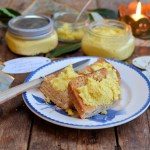
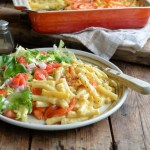
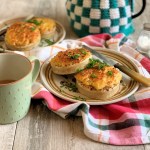
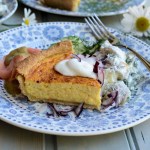


Nic | Nic's Adventures & Bakes says
Thanks for sharing, this looks an amazing three course meal, which all looks very yummy indeed 🙂
Karen Burns-Booth says
MY pleasure Nic